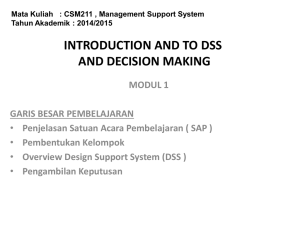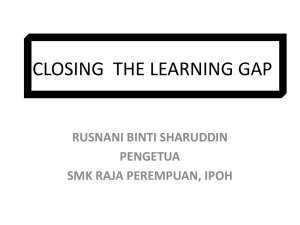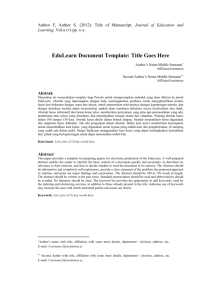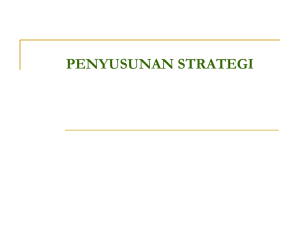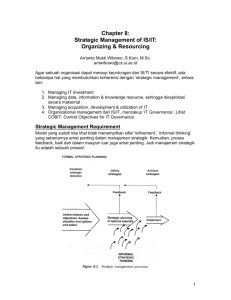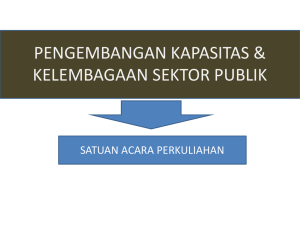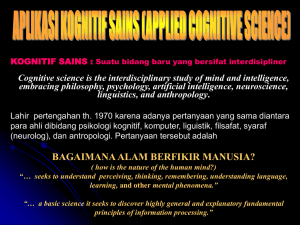Pertemuan 1-2 Arsitektur Teknologi Informasi
advertisement
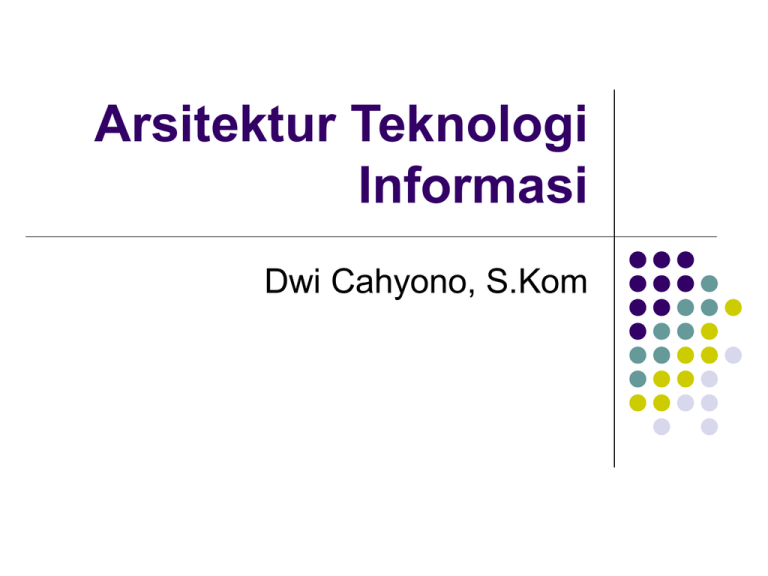
Arsitektur Teknologi Informasi Dwi Cahyono, S.Kom Apa ATI itu? Adalah blueprint sistem yang dibangun, diimplementasikan dan dimaintenance yang di gunakan untuk menjelaskan dan menunjukkan bagaimana organisasi IT dan elemen manajemen informasi bekerja sama untuk efisiensi dalam mendukung tujuan dari organisasi. Mengapa perlu ATI? Terdapat beberapa keuntungan Meningkatkan kemampuan dalam sharing dan efisiensi dalam proses untuk menghasilkan informasi (improved ability to share and efficiently process information). Kemampuan untuk merespon perkembangan teknologi yang sangat cepat dan kebutuhan dari bisnis Mengurangi biaya dikarenakan skala ekonomi dan sharing sumberdaya (reductions in costs because of economies of scale and resource sharing) How Do You Do an IT Architecture? Terdapat resiko dalam membangun Arsitektur IT (There are risks involved in doing an IT Architecture) Pada Organisasi besar ini akan membutuhkan waktu dan merupakan pekerjaan yang membutuhkan biaya yang mahal (In larger organizations it can become a time-consuming and potentially expensive task) Maximize the benefits : Anda harus mendefinisikan proses yang harus diikuti (you need to: have a defined process to follow) Mamahami proses (understand that process well) Mamastikan bahwa proses tersebut sesuai dengan situasi/keadaan dan kebutuhan (make sure that the process fits your situation and needs) When doing an IT Architecture you need to focus on: Aktifitas bisnis - the business activities (work) performed including performance measures, how they are organized, and where they take place Set data dan aliran informasi - the data sets and information flows needed to perform the activities Aplikasi dan Sotware - the applications and software needed to capture and manipulate the information sets Teknologi - and the technology (hardware, network,communications) needed to run the applications THE SEVEN STEP PROCESS One approach to doing IT architectures. STEP 1 - DEFINE YOUR VISION, OBJECTIVES, AND PRINCIPLES Who and what are your IT Architectural efforts (usaha) going to cover? What general IT principles will guide your efforts? Sebelum melakukan hal lain, diperlukan suatu visi dari apa yang sedang berusaha dipenuhi serta beberapa sasaran khusus. Langkah pertama yang lain harus menjadi seperangkat Prinsip Arsitektur TI - pernyataan dari pilihan arah atau praktek tentang bagaimana organisasi atau proses itu akan menggunakan TI. Ini dapat membantu untuk menyediakan konteks bagi keputusan arsitektur tertentu kemudian dalam proses dan juga membantu untuk membuat keputusan yang konsisten . Beberapa kelihatan begitu nyata bahwa pertanyaannya adalah mengapa begitu menyusahkan kita, tetapi dengan mendokumentasikan prinsip/aturan/role dan menjaganya sebagai proses maka kesulitan itu dapat dilewatkan. STEP 2 - CHARACTERIZE YOUR IT BASELINE How does your office do its business, what Information Technology is used, and how is it used? Langkah berikutnya dalam proses Arsitektur TI adalah mengetahui karakter dari sistem yang ada. Ambil / Capture Kapabilitas dari sistem TI yang ada. Mengetahui karakter dari sistem yang ada dalam arti bukan hanya dibutuhkan untuk mengidentifikasi dan menganalisa semua yang berkaitan dengan TI tetapi juga Informasi yang terkait dan mengalir pada semua organisasi yang terkait. Kita hanya membutuhkan data yang cukup untuk mengerti situasi dasar/sekarang dan masalah yang ada serta untuk membangun ide kemana kita akan mulai. Skala dari tugas ini tergantung, tentu saja, pada ukuran dan kompleksitas organisasi. The following are just examples – different organizations choose different ways of characterizing their baseline, but these give an idea on one approach. What Work is Performed? You must have a clear understanding of what work the organization performs and where it is performed (anywhere from one small location to throughout the nation or even the world). What Information is Needed for that Work and by Whom? You need to understand the basic flow of information, not just within your organization but also to and from outside customers or suppliers, and what the information consists of, how that information is organized, and whatever else is needed to give you a clear understanding of the information. What Applications are Used to Process that Information? What software is used to process, analyze, move, etc., the needed information? What types of file structures are used? What protocols are involved in transfers? What Technology is Used to Perform the Work? What IT hardware is currently used, including telecommunications and networking equipment? STEP 3 - CREATE A TARGET ARCHITECTURE What do you want your IT Architecture to look like in the future? At this point in the process you should know where you currently stand. Now you need to try to figure out where you would like to be (or need to be) in the future. How should the workflow ideally work? What generic types of applications and technology would be used? You are developing a model of What do you want your IT Architecture to look like in the future? the IT structure, not identifying the specific standards for products to be used (later you will create standards and guidelines that will be used by the organization for the acquisition of technology, applications, and services, but those are not the Target Architecture itself). To do this step effectively you must first understand the forces that are driving the need for change – the “drivers” in the business and technology areas. Business drivers are ones telling you that you need to do business differently. Customers may be demanding better or different services. Organizations that you work with may want to change how you exchange data. The methods now used to do business may not be cost efficient in the future. Or the drivers may be instructions from higher-level organizations or from laws. Technology drivers are ones that tell you that technology is giving or will give you options for doing things differently (and hopefully better). Many parts of the Department of Commerce, for instance, realized the potential of the Internet and started using it to provide products and services to the public long before any outside forces told them that they should do this. What other technologies are out there that may provide you with similar future opportunities? IT security is a particularly strong driver that should be addressed when developing all parts of the Architecture. By analyzing these drivers and your current baseline, you can start to define your future business and technology models – how you see the future business process working, the general technological tools needed to make that process effective, and how those tools need to interrelate. The Target Architecture is the heart of the process. The four components (business activities including performance measures, data sets and information flows, applications and software, and technology) of the IT Architecture need to be modeled separately. STEP 4 - DETERMINE THE GAPS BETWEEN YOUR CURRENT AND TARGET ARCHITECTURES What are the differences between your baseline and the architecture you want to achieve? So by this time you should know where you are now and where you want to be at some point in the future. It is time to evaluate how long that road is. How far is the organization from the target? The gaps have to be identified for each component of the IT Architecture. Where are the gaps large and where are they small? How difficult will it be to bridge those gaps? How much time, money, resistance from users, etc., may be involved? The nature of your organization plays a great role in this analysis. A smaller centralized organization or one where IT is controlled by one office will face different issues than a decentralized office with little or no central IT control. There may be gaps that are theoretically easy to solve - say a change with no complicated shift in technology and that will actually save money immediately – but that would face such fierce resistance by What are the differences between your baseline and the architecture you want to achieve? users that the organization would decide that there is a large and difficult gap here, with difficult decisions as to whether and how to bridge that gap. STEP 5 - DEVELOP A MIGRATION PLAN How will you bridge the gaps between the baseline and the Target Architecture? You now know your baseline, your Target Architecture, the gaps between the two, and the issues involved in bridging those gaps. The next step is to plan for when and how you are going to actually do that bridging. Many factors are involved, including those that you looked at in the gap analysis. Are there “quick wins” where the organization can realize benefits right away and for a minimal cost and effort? Besides the immediate benefits, these can show doubters the value of an IT Architecture. Or are the real problems ones that need immediate concentration on more major and long-term tasks? Which actions depend upon other actions to be effective? In some cases at least an informal costbenefit analysis may be needed. STEP 6 - IMPLEMENT THE MIGRATION PLAN AND ARCHITECTURE Start implementing the plan to bridge the IT architectural gaps. Obviously the steps leading up to this one will be of limited value if implementation never takes place. But what does “implementation” really mean? It does not necessarily mean that the organization must immediately convert its IT and information systems to the Target Architecture. If the IT Architecture is guiding the procurement and development of technology and systems, then it is being implemented, even if it may take a number of years before the Target Architecture’s goals are fully realized As mentioned above in Step 5, a migration plan can identify priorities where the application of the organization’s available resources and time can produce the greatest benefits. STEP 7 - REVIEW AND UPDATE REGULARLY An IT Architecture is a process, not a document. Technology is changing very quickly these days, and that trend doesn’t appear likely to slow down or stop. Business needs and processes also change over time. So a Target Architecture, whether fully implemented or not, that addresses how IT and information will serve business needs must be periodically reviewed and updated to reflect those changes.


